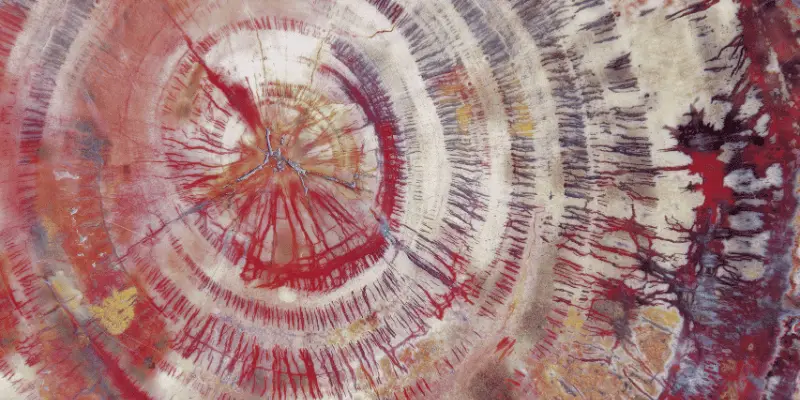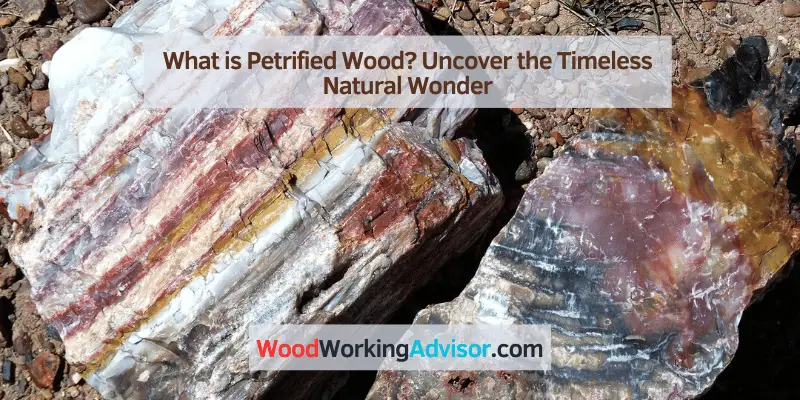Petrified wood is a type of fossil where organic material has been replaced by minerals. This transformation occurs through a process called permineralization.
Petrified wood holds a unique place in the annals of geology and paleobotany, chronicling the silent tales of ancient forests transformed into stone. This marvel of nature is created over millions of years as fallen trees become buried under sediment and mineral-rich water seeps through, depositing minerals into the plant’s cellular structure.
Perfect for collectors, educators, and enthusiasts, petrified wood pieces are not only visually stunning with their preserved rings and bark patterns but also serve as a poignant reminder of Earth’s dynamic history. Geological enthusiasts and tourists alike often visit famous sites, like the Petrified Forest National Park in Arizona, to witness the beauty and science encapsulated in these stone logs.
Unveiling Petrified Wood: A Timeless Wonder
Petrified wood is a fascinating geological formation where all organic material of a tree has been completely replaced by minerals through a process called permineralization. This occurs over millions of years where the wood is buried under sediment, preserving the original structure of the stem tissue.
The petrification process unfolds when wood becomes buried under sediment, protecting it from decay. Mineral-laden water flowing through the sediment deposits minerals in the plant’s cells and as the tree’s lignin and cellulose decay, a stone mould forms in its place. This process eventually turns the wood into a fossil, preserving the details of the wood’s original appearance.
| Phase | Description |
|---|---|
| Burial | Wood becomes buried under sediment. |
| Mineral Saturation | Mineral-rich water flows through, beginning the petrification. |
| Decay | Original wood components decay and minerals take their place. |
| Fossilization | Wood structure is preserved, turned into stone. |
The scientific phenomena at play involve minerals such as quartz, chalcedony, and opal. These minerals provide the petrified wood with its unique and varied colors. Through a combination of geochemical processes and geological timescales, wood transitions from a once living organic state to an inorganic fossil, capturing a moment in time for eternity.
Origins And Geology
Petrified wood is a type of fossilized tree or plant material where the organic materials have been replaced with minerals, typically silica, through a process known as permineralization. This amazing phenomenon requires specific geological conditions:
- The wood must be buried under sediment to protect it from decay due to oxygen and organisms.
- Mineral-rich water, flowing through the sediment, fills the pores and cells of the wood with silica and other minerals.
- This silicification process can preserve the minute detail of the wood, capturing its original structure.
While a variety of wood types can become petrified, those with hardwood species like oak and maple stand a high chance of petrification due to their dense structure. Remarkably, certain regions around the world are famous for their petrified forests, showcasing an incredible diversity of ancient plant life.
| Region | Notable Petrified Forest |
|---|---|
| Arizona, USA | Petrified Forest National Park |
| Egypt | Petrified Forest Protected Area |
| Argentina | Petrified Forest Natural Monument |
The Petrification Process Explained
Petrified wood is a natural phenomenon where organic material from trees turns into stone through a process called petrification. The transformation occurs when the original wood material is buried under layers of sediment and mineral-rich water flows through, initiating mineral deposition within the cellular structure of the wood.
During the initial phase, wood begins to decay and silica-rich minerals carried by groundwater infiltrate the wood’s porous structure. This step-by-step replacement of organic material leads to a stone-like fossil retaining the original wood’s shape.
Key elements like silicon dioxide are often pivotal in preserving intricate details of the wood. Over time, these minerals crystallize, solidifying the wood’s new form. The entire petrification process may span from a few thousand to millions of years, requiring the perfect balance of time and geological conditions for completion.
Petrified Wood In Human History
Petrified wood has served as a remarkable testament to nature’s artistry throughout human history. This fossilized material, which showcases wood transformed into stone by the process of permineralization, plays a pivotal role in archaeological discoveries and has divulged a wealth of information about long-gone ecosystems. Embedded deep in our past, petrified wood has been unearthed in numerous ancient sites, indicating its use in traditional craftsmanship.
Different civilizations have deeply revered petrified wood for its durability and beauty. Some cultures integrated it into their spiritual practices, associating it with qualities like longevity and wisdom. The significance attributed to petrified wood often reflected the civilization’s relationship with nature and their surrounding environments.
In contemporary times, petrified wood continues to entrance individuals as a popular material in fine jewelry and appealing home decor. Its intricate patterns and unique coloring, resulting from minerals such as quartz, pyrite, or opal, make each piece distinct. Designers and artisans often select petrified wood for creating luxurious and ornate items that resonate with the nostalgic charm of prior eras blended with modern aesthetics.
Identifying And Collecting Petrified Wood
Petrified wood, known for its stone-like qualities, is actually fossilized remnants of terrestrial vegetation. It’s crucial to recognize that over millions of years, organic plant material transitions into a silicate-based stone through a process called permineralization. Key physical characteristics include detailed patterns that mirror the original tree rings and bark textures, consistency in weight similar to regular stones, and a glassy or smooth finish. Collectors often covet specimens boasting vivid colors, which result from various minerals that seep into them during the petrification process.
Collecting petrified wood is subject to specific regulations, which vary depending on location. In many instances, it is illegal to remove petrified wood from national parks or to sell it without proper authorization. Ethical considerations suggest collectors should respect the environment and leave minimal impact on the natural settings.
- Researching local laws is imperative before attempting to collect petrified wood.
- Prioritizing areas where collecting is allowed, such as certain public lands or private properties with permission, ensures legal compliance.
- Novices should join gem and mineral societies or forums to gain knowledge from experienced collectors.
- Documenting finds with photographs and notes can enrich the overall collecting experience.
The Value Of Petrified Wood
The value of petrified wood is influenced by various factors. Some of the key determinants include the specimen’s size, the quality of preservation, and the vividness of its colors. Pieces with a high level of clarity and detail, where the original anatomical structures are well-preserved, are particularly sought after. The presence of rare elements, which can alter the color and pattern of the wood, also adds to the value.
Rarity plays a significant role; for instance, petrified wood from locations that are no longer accessible due to legal protections or geographical changes can fetch higher prices. The market comprises enthusiasts and serious collectors, as well as investors who see the wood as a unique and potentially appreciative asset. Active preservation efforts around the world aim to protect significant petrified wood sites, ensuring the longevity and future availability of these natural wonders.
Petrified Wood’s Role In Science And Education
Petrified wood serves as a critical window into Earth’s geological past, offering insights into the organic and inorganic processes that shaped our planet over millions of years. Substantial scientific research is anchored by the study of these ancient remains, which capture a moment in time where organic material transitioned to stone.
Fossils found in petrified wood unveil patterns of ancient plant life, contributing significantly to the fields of paleontology and geology. These specimens detail the environmental conditions, including climate and vegetation, of bygone eras. Their study enhances our understanding of evolutionary biology and the Earth’s climatic shifts.
In educational settings such as museums and academic institutions, petrified wood exhibits serve to enlighten and engage the public. They provide tangible connections to earth sciences, stimulating curiosity and fostering a deeper appreciation for the natural world. Such displays underscore the importance of preserving our planet’s history for future generations.

Preserving The Legacy
Petrified wood, a natural wonder spanning millions of years, captures a snapshot of ancient forest ecosystems. Its preservation is critical. Conservation efforts are multifaceted, seeking not only to protect this geological heritage but also to educate the public about its significance.
National parks and protected areas play a vital role in safeguarding petrified forests. By enforcing regulations that prohibit collection and vandalism, these sanctuaries ensure the longevity of petrified wood. Initiatives to curtail illegal activities and promote sustainable tourism are essential parts of their conservation strategies.
The challenges in protecting petrified wood sites are daunting. Natural erosive processes, alongside human-induced damage, threaten these ancient remains. Tackling these issues necessitates a collaborative approach, combining legal frameworks, scientific research, and community engagement to preserve these remnants of prehistoric life for future generations.
Visiting Petrified Forests
Petrified forests around the world attract visitors with their unique geological wonders. One of the most renowned sites is the Petrified Forest National Park in Arizona, USA, which boasts a vast collection of vibrantly colored petrified wood. Another notable destination is the Petrified Forest of Lesvos, Greece, recognized as a UNESCO Global Geopark for its well-preserved fossilized remains from the Miocene era. Travelers to these remarkable natural museums can engage in various activities such as guided tours, hiking trails, and educational exhibits which provide insights into the fascinating process of wood petrification.
Sustainable tourism is a pivotal aspect of managing these ancient marvels. Efforts include setting up designated pathways to minimize human impact, implementing strict ‘leave no trace’ policies, and encouraging ecological awareness among visitors. These measures ensure the protection of petrified forests for future generations while providing a memorable experience for today’s eco-conscious travelers.
Frequently Asked Questions On What Is Petrified Wood
What Is So Special About Petrified Wood?
Petrified wood is special because it’s fossilized remains of terrestrial vegetation, where the organic materials have been replaced with minerals, essentially turning wood into stone, preserving its structure. It showcases ancient natural history and often features a beautiful, multicolored appearance.
Is Petrified Wood A Rock Or A Stone?
Petrified wood is a type of fossilized mineral that geologists classify as a stone. Over time, its organic material has been replaced by minerals, transforming it into a solid, rock-like structure.
How Does Wood Become Petrified?
Wood becomes petrified through a process called permineralization. Minerals in water infiltrate decaying wood, replacing organic material with stone while retaining the wood’s structure. Over time, this mineral replacement transforms the wood into a fossil, preserving its details in rock form.
What Is Petrified Wood And How Old Is It?
Petrified wood is a type of fossil where organic material has been replaced by minerals over time, preserving the wood’s structure. It typically dates back millions of years, often ranging from 3. 5 million to 200 million years old.
Conclusion
Petrified wood tells a remarkable story of time and transformation. By understanding what it is, we embrace nature’s alchemy, turning wood into stone. Collectors and scientists alike marvel at its beauty and significance. As the Earth continues to reveal its secrets, petrified wood remains a fascinating chapter in our planet’s history.
Embrace this natural wonder and let your curiosity about the ancient world grow.


